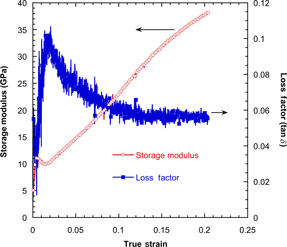Article contents
Continuous dynamic analysis: evolution of elastic properties with strain
Published online by Cambridge University Press: 03 January 2014
Abstract

Mechanical strain triggers changes in inherent molecular structure, especially in polymeric and biological materials. Unlike conventional techniques, we demonstrate a novel dynamic mechanical characterization method to study the effect of this structural evolution with strain on elastic properties. During tensile characterization of small diameter fibers, we quantitatively measured the viscoelastic properties as a continuous function of strain. While this approach is useful to characterize the elastic properties of metal microwires independent of applied strain, it is extremely important for fundamental understanding of molecular changes and their effect on the viscoelastic properties in materials such as polymer fiber and spider silk.
- Type
- Research Letters
- Information
- Copyright
- Copyright © Materials Research Society 2014
References
- 7
- Cited by




